Today starts a two-day workshop at EYE Filmmuseum in Amsterdam for international researchers and people from the archives, a workshop on the Italian Silent Cinema. The participants will take a dive into EYE's film and non-film collections. They will discuss the close relationship that Italian cinema has with other arts and will work on a corpus of films, but also on advertising material that will highlight the richness and inventiveness of the decorative arts and graphics of the silent period. For this post we asked one of the workshop organisers, Ivo Blom, to dive into his own postcard collection and to share his comments with us.
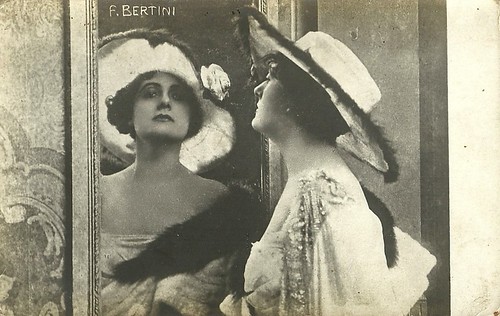
American postcard by monogram K Ltd. Photo: Francesca Bertini in Odette (Giuseppe De Liguoro, 1916). Ivo Blom: "EYE has a rich collection of films with Francesca Bertini, from her early days at Film d'Arte Italiana and short films at the Cines company to her days as a film diva in features at the Celio and Caesar studios. The Bertini films are striking for their highly emotional performances, but also for their sophisticated settings and for the wealth of costume design."
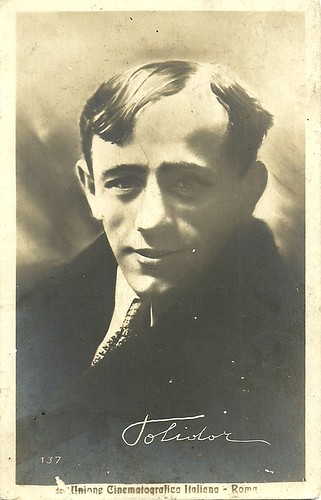
Polidor. Italian postcard by La Rotofotografica / Unione Cinematografica Italiana, no. 137. Ivo: "For a long time, Italian silent comedy was conceived as only slapstick. Research in film collections has proven that the genre was more diverse. In addition to the typical chaser comedies with Cretinetti and Robinet, the Polidor comedies had a strong background in the circus world, which shows in films with lions, bears, elephants and so on."
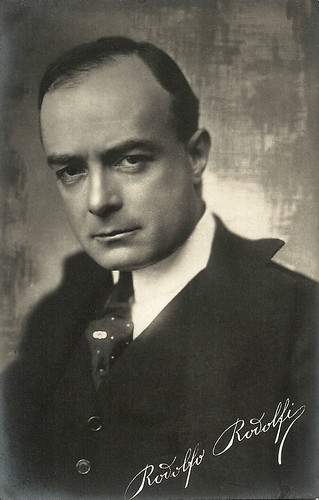
Eleuterio Rodolfi. Italian postcard by Fotocelere. Ivo: "For Ambrosio, Rodolfi acted in some 95 films of which some 80 were directed and scripted by himself. Many of these were comedies interpreted by Rodolfi together with actress Gigetta Morano, known as ‘Gigetta’ and ‘Rodolfi’. The comedies with Gigetta and Rodolfi were true ‘commedie’, situational, boulevardier, and often hinting at forbidden fruits and voyeurism. I like their film Acqua miracolosa very, very much."
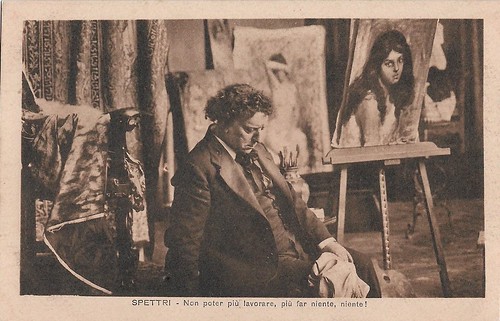
Italian postcard. Photo: Milano Film. Ermete Zacconi in Spettri/Gli spettri (A.G. Caldiera, 1918), adapted from Henrik Ibsen's Ghosts (Gengangere, 1881). Caption: Not being able anymore to paint, to do anything, nothing! Ivo: "Spettri is a good example of the representation of art and artists in Italian silent cinema. An artist feels doomed as he becomes paralysed because of his father's syphilis. It ruins his career as a painter. Finally, he asks his mother to end his sufferings. Ermete Zacconi reached the maximum of realism with his shocking performance."
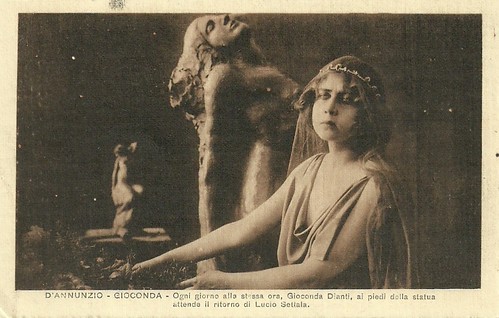
Italian postcard by IPA CT, no. 3662. Photo: Film della Società Ambrosio, Torino. Censura Terni, 18-4-1917. Publicity still from La Gioconda (Eleuterio Rodolfi, 1917) with Helena Makowska as the model Gioconda Dianti. Caption: Every night at the same hour, Gioconda Dianti, at the feet of the statue awaited the return of Lucio Settala. Ivo: "In Italian silent cinema, sculptures often work as catalysts. In La Gioconda, Makowska's artist model wrecks the family of the sculptor Lucio Settala. At the climax of the film, the wife and the mistress fight and Gioconda tries to smash the statue that is her effigy, but the wife saves it at the loss of both her arms. Shocked by so much self-sacrifice, the husband returns to his wife. Sadly, La Gioconda is a lost film."
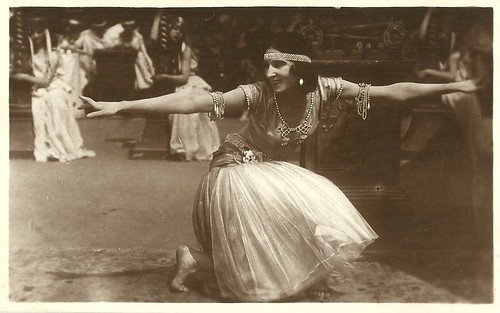
Italian postcard by Unione Cinematografica Italiana. Photo: publicity still for La nave (Gabriellino D'Annunzio, Mario Roncoroni, 1921), based on the homonymous play by Gabriele D'Annunzio. Star of the film was the Russian dancer and actress Ida Rubinstein. Ivo: "Dance is one of the central themes of the workshop. In an extended dance scene in La nave, Rubinstein's character Basiliola seduces Sergio, the lecherous bishop. This scene contains the only moving images of Rubinstein dancing, and owes a great deal to Oscar Wilde's and Richard Strauss's' Salome."
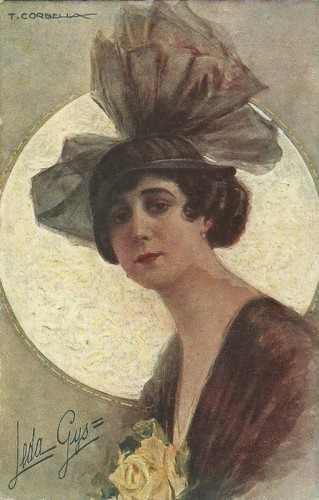
Italian postcard. Image: Leda Gys by Tito Corbella. Ivo: "In the 1910s, Tito Corbella was an acclaimed film poster designer, but he also designed a series of postcards with the most popular Italian divas. Leda Gys is well represented in the workshop, for example in the two-reeler Amore bendato (Ivo Illuminati, 1913), a Celio production."
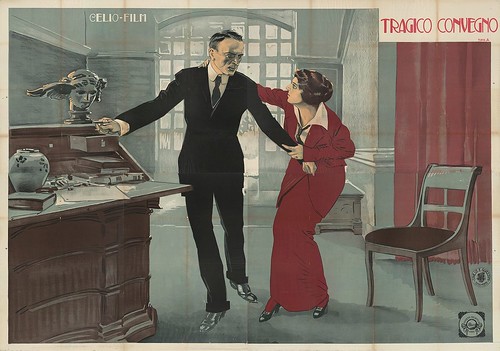
Italian film poster, designed by Tito Corbella for Tragico convegno (Ivo Illuminati, 1915), starring Maria Jacobini. Collection: EYE Filmmuseum. Ivo: "This poster belongs to the Desmet Collection, a Unesco World Heritage Collection. Italian film posters of the 1910s are remarkable for their stylish, modernist design by acclaimed artists such as Leopoldo Metlicovitz, Aleardo Terzi, and Tito Corbella. The film Tragico convegno was long considered lost, but recently resurfaced and was restored by EYE."
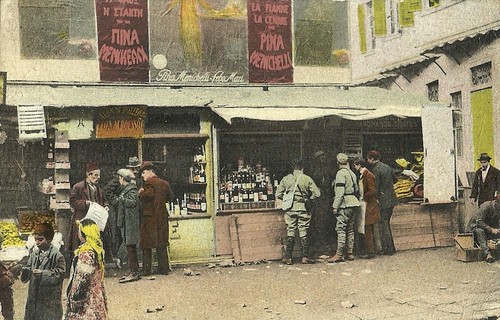
Italian postcard by IPA CT Autocromo. Censured at Terni, 10 October 1917. Photo: Henri Manuel. Caption on the back: "Poor shops still do paying business." Ivo: "Sometimes, old postcards give insight in how film posters were a part of streetlife. Here is a postcard depicting Saloniki in Greece during the First World War. Above the shops, posters are visible for the Itala production Il Fuoco (1915), by and with Febo Mari, and starring Italian diva Pina Menichelli. I was very pleased to find this rare postcard."
Scene from Sangue bleu (Nino Oxilia, 1914). Source: Silents, Please!
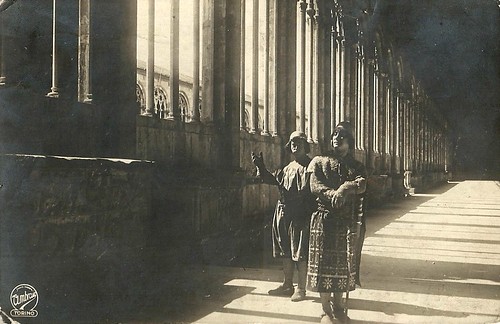
Italian postcard. Photo: Ambrosio Film. Publicity still for La Gorgona (Mario Caserini, 1915), scripted by Arrigo Frusta and starring Annibale Ninchi and Madeleine Céliat. The film was based on a play by Sem Benelli. Ivo: "I always thought that the typical use of light stripes were a feat of the diva films, such as those in Sangue bleu when Francesca Bertini passes a corridor. However, these light effects were apparently also common in Italian historical films such as La Gorgona. I consider lighting in general to be highly inventive in Italian silent cinema."
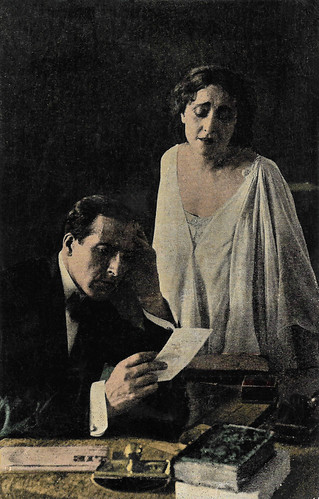
Spanish collectors card by Chocolat Imperiale. Imp. Bayer Hnos. y C.a. Chromophotography. "El drama de una noche" was the Spanish release title of the Italian melodrama Il dramma di una notte/The Drama of One Night (Mario Caserini, 1918), starring Lyda Borelli. The film was distributed in Spain during WWI by the company José Montanola, Barcelona. Ivo: "Borelli's last film was considered lost, but recently a ten-minutes-fragment was found at EYE Filmmuseum. Despite its shortness, the clip shows the whole melodrama as if it were a trailer. Borelli's character's dark past haunts her at the brink of her marriage. A former client of her life in Calcutta proves to be the brother of her future husband and he threatens to expose her. Only an Indian poison can save her reputation. It's an excellent example of a 1910s melodrama, one of the themes of the workshop."
Admission to the workshop is closed, but all the debates will be recorded and published online.
Thank you, Ivo!

American postcard by monogram K Ltd. Photo: Francesca Bertini in Odette (Giuseppe De Liguoro, 1916). Ivo Blom: "EYE has a rich collection of films with Francesca Bertini, from her early days at Film d'Arte Italiana and short films at the Cines company to her days as a film diva in features at the Celio and Caesar studios. The Bertini films are striking for their highly emotional performances, but also for their sophisticated settings and for the wealth of costume design."

Polidor. Italian postcard by La Rotofotografica / Unione Cinematografica Italiana, no. 137. Ivo: "For a long time, Italian silent comedy was conceived as only slapstick. Research in film collections has proven that the genre was more diverse. In addition to the typical chaser comedies with Cretinetti and Robinet, the Polidor comedies had a strong background in the circus world, which shows in films with lions, bears, elephants and so on."

Eleuterio Rodolfi. Italian postcard by Fotocelere. Ivo: "For Ambrosio, Rodolfi acted in some 95 films of which some 80 were directed and scripted by himself. Many of these were comedies interpreted by Rodolfi together with actress Gigetta Morano, known as ‘Gigetta’ and ‘Rodolfi’. The comedies with Gigetta and Rodolfi were true ‘commedie’, situational, boulevardier, and often hinting at forbidden fruits and voyeurism. I like their film Acqua miracolosa very, very much."

Italian postcard. Photo: Milano Film. Ermete Zacconi in Spettri/Gli spettri (A.G. Caldiera, 1918), adapted from Henrik Ibsen's Ghosts (Gengangere, 1881). Caption: Not being able anymore to paint, to do anything, nothing! Ivo: "Spettri is a good example of the representation of art and artists in Italian silent cinema. An artist feels doomed as he becomes paralysed because of his father's syphilis. It ruins his career as a painter. Finally, he asks his mother to end his sufferings. Ermete Zacconi reached the maximum of realism with his shocking performance."

Italian postcard by IPA CT, no. 3662. Photo: Film della Società Ambrosio, Torino. Censura Terni, 18-4-1917. Publicity still from La Gioconda (Eleuterio Rodolfi, 1917) with Helena Makowska as the model Gioconda Dianti. Caption: Every night at the same hour, Gioconda Dianti, at the feet of the statue awaited the return of Lucio Settala. Ivo: "In Italian silent cinema, sculptures often work as catalysts. In La Gioconda, Makowska's artist model wrecks the family of the sculptor Lucio Settala. At the climax of the film, the wife and the mistress fight and Gioconda tries to smash the statue that is her effigy, but the wife saves it at the loss of both her arms. Shocked by so much self-sacrifice, the husband returns to his wife. Sadly, La Gioconda is a lost film."

Italian postcard by Unione Cinematografica Italiana. Photo: publicity still for La nave (Gabriellino D'Annunzio, Mario Roncoroni, 1921), based on the homonymous play by Gabriele D'Annunzio. Star of the film was the Russian dancer and actress Ida Rubinstein. Ivo: "Dance is one of the central themes of the workshop. In an extended dance scene in La nave, Rubinstein's character Basiliola seduces Sergio, the lecherous bishop. This scene contains the only moving images of Rubinstein dancing, and owes a great deal to Oscar Wilde's and Richard Strauss's' Salome."

Italian postcard. Image: Leda Gys by Tito Corbella. Ivo: "In the 1910s, Tito Corbella was an acclaimed film poster designer, but he also designed a series of postcards with the most popular Italian divas. Leda Gys is well represented in the workshop, for example in the two-reeler Amore bendato (Ivo Illuminati, 1913), a Celio production."

Italian film poster, designed by Tito Corbella for Tragico convegno (Ivo Illuminati, 1915), starring Maria Jacobini. Collection: EYE Filmmuseum. Ivo: "This poster belongs to the Desmet Collection, a Unesco World Heritage Collection. Italian film posters of the 1910s are remarkable for their stylish, modernist design by acclaimed artists such as Leopoldo Metlicovitz, Aleardo Terzi, and Tito Corbella. The film Tragico convegno was long considered lost, but recently resurfaced and was restored by EYE."

Italian postcard by IPA CT Autocromo. Censured at Terni, 10 October 1917. Photo: Henri Manuel. Caption on the back: "Poor shops still do paying business." Ivo: "Sometimes, old postcards give insight in how film posters were a part of streetlife. Here is a postcard depicting Saloniki in Greece during the First World War. Above the shops, posters are visible for the Itala production Il Fuoco (1915), by and with Febo Mari, and starring Italian diva Pina Menichelli. I was very pleased to find this rare postcard."
Scene from Sangue bleu (Nino Oxilia, 1914). Source: Silents, Please!

Italian postcard. Photo: Ambrosio Film. Publicity still for La Gorgona (Mario Caserini, 1915), scripted by Arrigo Frusta and starring Annibale Ninchi and Madeleine Céliat. The film was based on a play by Sem Benelli. Ivo: "I always thought that the typical use of light stripes were a feat of the diva films, such as those in Sangue bleu when Francesca Bertini passes a corridor. However, these light effects were apparently also common in Italian historical films such as La Gorgona. I consider lighting in general to be highly inventive in Italian silent cinema."

Spanish collectors card by Chocolat Imperiale. Imp. Bayer Hnos. y C.a. Chromophotography. "El drama de una noche" was the Spanish release title of the Italian melodrama Il dramma di una notte/The Drama of One Night (Mario Caserini, 1918), starring Lyda Borelli. The film was distributed in Spain during WWI by the company José Montanola, Barcelona. Ivo: "Borelli's last film was considered lost, but recently a ten-minutes-fragment was found at EYE Filmmuseum. Despite its shortness, the clip shows the whole melodrama as if it were a trailer. Borelli's character's dark past haunts her at the brink of her marriage. A former client of her life in Calcutta proves to be the brother of her future husband and he threatens to expose her. Only an Indian poison can save her reputation. It's an excellent example of a 1910s melodrama, one of the themes of the workshop."
Admission to the workshop is closed, but all the debates will be recorded and published online.
Thank you, Ivo!

No comments:
Post a Comment